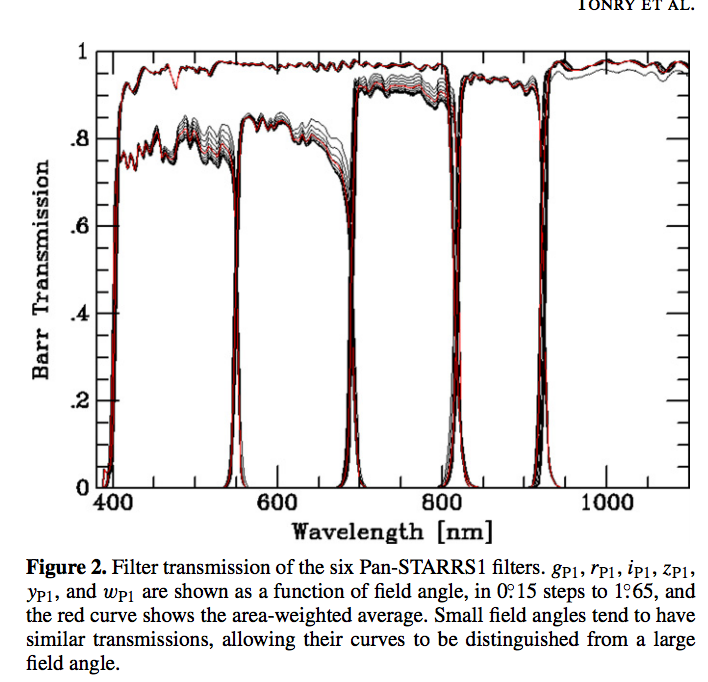Page History
Versions Compared
Key
- This line was added.
- This line was removed.
- Formatting was changed.
This page provides an overview of the photometric system onto which Pan-STARRS PS1 is defined. It combines accurate measurements of the filter bandpass edges and throughput curves with measurements of HST Calspec standards with the PS1 system.
| Tip | ||||||
|---|---|---|---|---|---|---|
| ||||||
|
The
starting point for the PS1 data archive is at The Pan-STARRS1 data archive home page.PS1 Photometric Calibration
The PS1 photometric calibration is initially presented in Tonry et al. 2012 ( http://adsabs.harvard.edu/abs/2012ApJ...750...99T), which itself is based on and Stubbs et al. 2010 (http://adsabs.harvard.edu/abs/2010ApJS..191..376S). These . These analyses use a laser diode system to accurately and precisely determine the filter bandpass edges and throughput curves (roughly to 7 A in mean effective wavelength). These curves are shown here (Armin insert here!):
, shown in the PS1 Filter properties page.
The flux calibration of PS1 measurements relies on an iterative process that includes work from Tonry et al. 2012 and Schlafly et al. 2012 (http://adsabs.harvard.edu/abs/2012ApJ...756..158S) and is augmented by Scolnic et al. 2015 (http://adsabs.harvard.edu/abs/2015ApJ...815..117S). Both . Both Tonry et al. 2012 and Scolnic et al. 2015 analyze PS1 observations of HST HST Calspec standards and compares the observed magnitudes of these standards to the predicted magnitudes from synthetic photometry. One One can then finds the AB offsets so that the observed magnitudes best matches the synthetic photometry, given fixed constraints from measurements on the bandpass edges and shapes. The synthetic spectra can be found on the Calspec website {http://www.stsci.edu/hst/observatory/crds/calspec.html}. Note . Note that for the latest PS1 analysis, Calspec version 005 was used. The update between Tonry et al. 2012 and Scolnic et al. 2015 is that Scolnic et al. 2015 was done after the PS1 ubercal was set up to find the AB offsets, but still uses the filter functions measured by Tonry et al. 2012. The PS1 photometry is based on the updated photometric calibration from Scolnic et al. 2015
Ubercal
The PS1 Ubercal is discussed on the PS1 relative calibration page (https://confluence.stsci.edu/display/PSPS/PS1%3A+Relative+Photometric+Calibration). in PS1 Relative Photometric Calibration. Since PS1 Ubercal calibrated 3pi of the sky, which covered the location of many HST Calspec standards, there are then well calibrated observations of several Calspec standards. Their observed and synthetic magnitudes are given in Scolnic et al. 2015, and the listing is: SF1615, Snap-1, Snap-2, WD1657, KF06T2, lds749b, C26202 which are chosen to avoid saturation limits/non-linearity limits of 14.3, 14.4, 14.6, 14.6 mag in grizy. Furthermore, specific observations near the center of the focal plane are avoided due to the fast-varying PSF within 0.1 degree of the center of the focal plane (though this is largely mitigated by the finely sampled flat field solution from Schlafly et al. 2012).
The AB zeropoints and filters are given for the median radius of the focal plane. Scolnic et al. 2014 (http://iopscience.iop.org/article/10.1088/0004-637X/795/1/45/pdf) analyzes the variation of filter transmission functions across the focal plane and finds the variations across the focal plane with a radial dependence for stars with 0.4<g-i<1.5 to be up to $8$ 8 mmag (due to the design of the filters), though typically at a dispersion level of ~2 mmag. The filter throughput is measured at multiple radial positions, and brightnesses can be corrected based on radial position on the focal plane. (Armin insert filter variation here).
 Image Added
Image Added
Transformations to Other Systems
PS1 survey photometry can be transformed to multiple other systems. This This is described in Scolnic et al. 2015 using the Supercal process. The The systems with current transformations are SDSS, CFHT, Landolt, Swope, Keplercam. DECam DECam has also been transformed, though has not been included in this work (Armin - cite Annalisa's result?). Offsets between the transformations are shown here:
(Armin insert Supercal plot here).
To transform PS1 to other systems, we include Supercal generated lookup tables for two libraries (Calspec and NGSL) that have for any given standard, what their synthetic magnitudes are for different systems. A folder is here with a README attached. For further questions, email To retrieve this folder, email dscolnic@kicp.uchicago.edu(Armin insert zip folder here)
